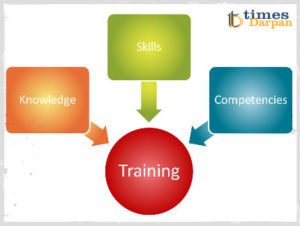Training is an organised process for increasing the knowledge and skills of people for doing a particular job.
Training refers to the posses of imparting specific skills. It is a learning process involving the acquisition of skills and attitude.
The main purpose of the training is to improve the current performance level of the employees in an organisation.
It includes the learning of such techniques as are required for the better performance or definite tasks.
Definition of Training
Edwin. B. Flippo defined that “Training is the act of increasing the knowledge and skills of an employee for doing a particular job.”
According to Dale S.Beach “Training is the organized procedure in which people learn knowledge and or skills for definite purpose.”
Need for Training
Need for training arises on account of the following reasons.
Reason 1: New Environment
When a new employee comes to work he is unaware of the environment in the organisation. Therefore, he should be given some training to make him familiar with this job, his superiors and peers, company’s rules and regulations.
It enables the new employee to gain self-confidence and to adjust himself in the new environment.
Reason 2: Lack of Trained Personnel
It is always not possible to recruit and select trained employees. When workers with little or no training are selected, they require training for efficient performance on the job.
Some employees might posses theoretical knowledge, which has to be supplemented with training on the specific job. Such training is called job training.
Reason 3: Advancement in Technology
Training helps to provide mastery in new methods and machines. When improvements take place in the techniques of work, employee have to be trained to become proficient in latest methods of doing work.
This learning of new methods and updating of knowledge is known as refresher training.
It helps the employees to keep up with new methods and techniques and new machine of doing work.
Reason 4: Faulty Methods
Training is required to remove these defects and to teach them correct methods and behavior patterns.
This type of training may be called remedial training.
Reason 5: prevention of Accidents
Training is needed to prevent industrial accidents. For this purpose safety consciousness must be created among workers so that they realize the significance of safe working.
Reason 6: Career Development
When persons working at lower levels are promoted to higher positions, they require training in the higher job. This is necessary not only to replace the outgoing executives but also to provide opportunity for advancement to the employees.
Advantages of Training
Training and development offer competitive advantage to a firm by removing performance deficiencies; making employees stay long; minimizing accidents, scrap and damage, and meeting future employee needs.

The main benefits of training are given below:-
Benefit 1: Increased Productivity
Training increases the knowledge, skills and attitude of employees. Therefore, well-trained employees give better performance on the job.
Training results in higher quantity and quality of output.
Benefit 2: job satisfaction
Training builds self-confidence in the employees and enables them to achieve the required level of performance.
Their attitude becomes more positive and co-operative. Turnover and absenteeism are reduced.
Benefit 3: Reduction of Accidents
Proper training develops safety attitudes and helps to reduce the accident rate.
Benefit 4: Better use of resources
Well-trained employees make better use of machines and materials. There is less breakage of machinery and tools.
The maintenance cost is related and life of machines is increased. Cost of production per unit is reduced.
Benefit 5: Reduced Supervision
Trained employees need less guidance. Therefore need for supervision is reduced.
The span if supervision can be increased and the cost of supervision reduced.
Benefit 6: Greater Flexibility
An organisation with trained personnel can introduce latest technology to reduce costs of production. Trained employees show less resistance to change.
The enterprise can easily adjust to short-term variations in the volume of work.
Benefit 7: Management by Exception
Trained employees are self-dependent and can perform routine work independently. Therefore, supervisors can easily delegate authority and reduce their workload.
Benefit 8: Stability and Growth
It can also meet the personnel needs for growth and expansion. Training provides a second line of personnel, which helps to ensure long-term stability and growth of the organisation.
Objectives of Training
The objectives of training are given below in point:
Point 1: To increase the knowledge of workers in doing specific job.
Point 2: To impact new skills among the workers systematically, so that they learn quickly.
Point 3: To bring out change in the attitude of the workers towards fellow workers, supervisor and the organisation.
Point 4: To improve the overall performance of the organisation.
Point 5: To make the workers handle materials, machines and equipment efficiently and thus to check wastage of time and resources.
Point 6: To reduce the number of accidents by providing safety training to workers.
Point 7: To prepare workers for higher jobs by developing advanced skills in them.
Point 8: To promote individual and collective morale, a sense of responsibility, cooperative attitudes and good relationships.
Point 9: To ensure smooth and efficient working of a department.
Point 10: to ensure economical output of required quality.
Point 11: To impart the new entrants the basic knowledge and skill they need for an intelligent performance of definite job.
Importance of Training
The importance of training may be stated as follows :
N 1: Improvement in skill and knowledge
Training, certainly, results in improvement in the skill and knowledge of the employee. This helps the employee to perform his job much better.
This benefit the enterprise as well.
N 2: Higher production and productivity
If an enterprise has a team of well-trained employees, it will be able to expand its production.
There will be a rise not only in production in terms of a number of units but also in productivity.
N 3: Job satisfaction
Well-trained employees are able to perform their jobs with a higher degree of skill. This increases their level of self-confidence and commitment to work.
N 4: Better use of Resources
Trained employees will be able to make better use of the materials and machines.
This reduces the rate of wastage and spoilage of materials and also breakage of tools and machines. The maintenance cost too is bound to come down.
N 5: Reduction in accidents
Trained employees are aware of the safety precautions to be taken while at work. They are always alert and cautious.
This is bound to bring down the number of accidents in the workplace.
N 6: Reduced Supervision
Well-trained employees do not need much supervision. They can do their work without having to approach their superiors often for guidance.
N 7: Reduction in Complaints
Only bad workers blame the tools. An employee who has acquired the necessary skill and job knowledge would certainly love his job.
Such am employee does not complain about anyone and anything.
N 8: Adaptability
Trained workers do not resist change. They have the capacity to adapt themselves to any kind of situation.
N 9: Scope for management by exception
With trained workers working under them, it becomes easy for the managers to get things done by delegating authority.
N 10: Stability
If an organisation has a team of trained employees it can face future challenges easily.
The employees of today are going to be managers an organisation if it has a team of trained, efficient and committed employees who are ever ready to take over management.
Type of Training
Several types of training programmes are offered to the employees on several purpose. They invariably overlap and employ many common techniques.
The important types of training programmes are as follows:
Type 1: Induction or Orientation Training
Induction is concerned with inducting or orienting a new employee to the organisation and its procedures, rules and regulations.
It is better to give him a friendly welcome when he joins the organisation, get him introduced to the organisation and help him to get a general idea about the rules and regulations, working conditions etc., of the organisation.
Type 2: Job Training
Job training relates to specific job which the worker has to handle. It gives information about machines. Process of production. Instructions to be followed and methods to be used and so on.
Job training is the most common of formal in-plant training programmes. It helps in creating interest of the employee in their jobs.
Type 3: Apprenticeship Training
Apprenticeship training programmes tends more towards education than merely on the vocational training.
The usual apprenticeship programmes combine on the job training and experience with classroom instructions in particular subjects.
The government of various countries have passed laws which make it obligatory on certain classes of employers to provide apprenticeship training to the young people.
Type 4: Internship Training
Under this method, the educational or vocational institute enters into arrangement with an industrial enterprise for providing practical knowledge to its students.
Internship training is usually meant for such vocation where advanced theoretical knowledge is to be backed up by practical experience on the job.
It is quite usual that enterprise giving them training absorb them by offering suitable job.
Type 5: Refresher training or retraining
The refresher training is meant or the old employees of the enterprise.
The basic purpose of refresher training is to acquaint the existing workforce with the latest methods of performing their jobs and improve their efficiency further.
The workers require training to bring them up-to-date with the knowledge and skills and to relearn what they have forgotten.
The workers need to learn new work methods to use new techniques in doing their jobs.
Type 6: Training for promotion
The talented employees may be given adequate training to make them eligible for promotion to higher jobs in the organisation.
The purpose of training for promotion is to develop the existing employees to make them fit for undertaking higher job responsibilities.
This serves as a motivating force to the employees.
At last words, training and development is important programme as it leads stability and flexibility to an organisation, besides contribution to its capacity to grow. Skills, education, development ethics, attitudinal changes and decision-making skills must to go into any programme of training and development.
Related Topic :-
Note :- For any quires of this article, you can comment us and For Contact with us you can like our Facebook page to and Subscribe to the YouTube channel.













